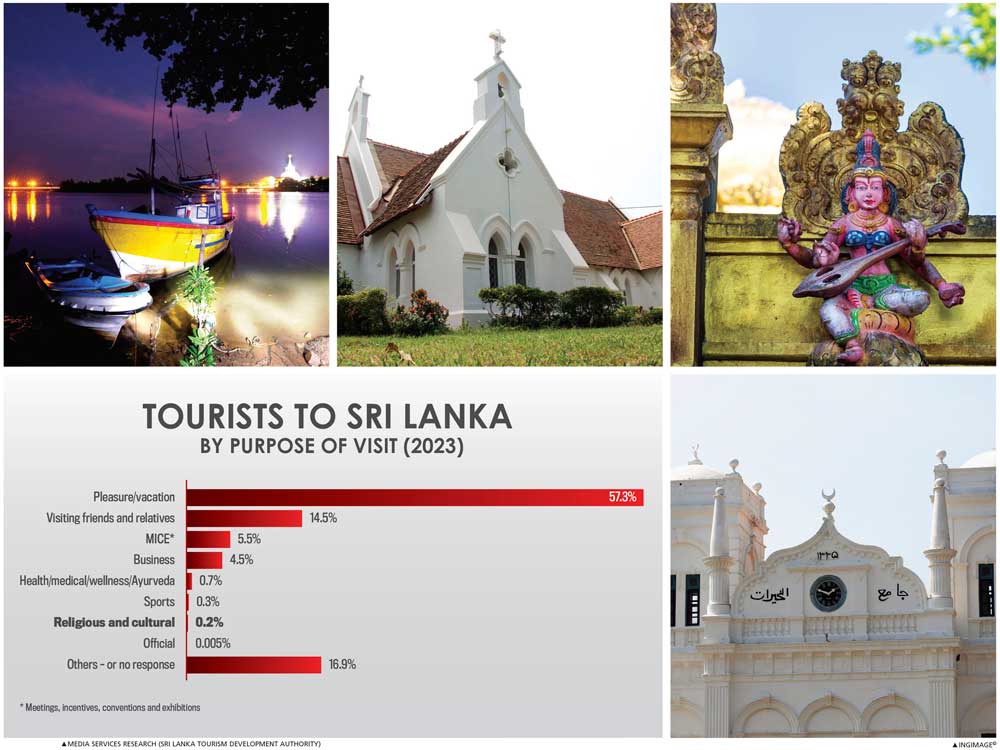SEE RAVANA’S REVENUES FLY
Wijith DeChickera explores the potential of religious and cultural tourism to boost Sri Lanka’s future foreign exchange earnings

Of all those visitors, only a paltry 0.2 percent reported arriving on our shores for religious reasons
The best-known exemplars of countries successfully exporting their cultural and religious tourism products are no-brainers for tourists tuned in to otherworldly realities. If you had to venture a guess as an armchair traveller, what would your leading destinations be?
In a January 2024 article titled ‘Temples to tranquillity: 16 top spiritual and religious destinations in the world,’ the authors of the blog Headout suggest what these are.
So in order, Varanasi (Benares), one of the oldest living cities in the world and the holiest city in India; Vatican City, an independent city-state enclaved within Rome and administrative centre of the Roman Catholic Church that’s a religious pilgrimage site, and also a hub of art, culture and history; and Jerusalem in Israel-Palestine, a city sacred to three of the world’s major religions – viz. Judaism, Christianity and Islam.
On Headout’s top 16 list are tropical paradise Bali in Indonesia, an island famous for its stunning beaches, lush forests and unique Hindu culture (No. 4); Tibetan Lhasa, numbered six, one of the most spiritual cities in the world; Bodh Gaya – in India, in eighth place – the Buddha’s place of attaining enlightenment (his birthplace Lumbini in Nepal ranks 11th); and Saudi Arabia’s Mecca, Islam’s holiest city (ranking ninth).
There are also the iconic Machu Picchu in Peru at No. 12, hosting the world’s most famous Incan citadel; Cambodia’s Angkor Wat, a vast temple complex housing the largest religious monuments in the world, in 13th place; and Amritsar in India at No. 14, which is home to the iconic Golden Temple that’s venerated by Sikhs.
An article titled ‘The growth trajectory of religious tourism in key markets’ by the Oxford Business Group (OBG) makes instructive reading for national authorities interested in boosting Sri Lanka’s foreign exchange earnings lucratively.
In its Economic Update published in May 2023, OBG reveals that while global revenue from faith based tourism was projected to reach US$ 1 billion by the end of that year, the figure could reach 41 billion dollars in 2033.
An estimated 330 million people travel for religious reasons every year, according to a 2017 UN World Tourism Organization (UNWTO) study – including travellers pursuing spiritual and sightseeing opportunities in countries with sacred, historical and culturally significant sites.
This study reported that a quarter of global travellers expressed interest in religious and cultural tourism, whether for spiritual or non-spiritual reasons.
Of potential interest for not only Sri Lanka’s tourism authorities but also its national policy planners, OBG asserts that “in addition to supporting job creation and local economies, religious tourism is helping to spur investment in logistics infrastructure,” and nature protection and conservation, promoting wider recreational offerings.
In India, which showcases sites important to several world faiths, religious tourism inflows reached record highs recently. Gujarat saw tourism inflows surpass US$ 44 million in 2017, of which more than 35 percent redounded to religious tourism.
Saudi Arabia hosted over 17 million international tourists in 2019, of whom a little less than 2.5 million were pilgrims to Mecca, while subcontinental tour operators say their businesses are recording growth rates of 15 percent above pre-pandemic levels.
The desert kingdom plans to attract 30 million religious tourists in 2030, and invested 35 billion dollars in the redevelopment of King Abdulaziz International Airport and US$ 16 billion in the Makkah Metro project to streamline visitor transport in Mecca.
Other Middle East and North Africa (MENA) nations are also restoring, preserving and promoting cultural-religious sites.
All this to rehearse the potential of an eminently great destination for cultural and religious tourism – Sri Lanka: ‘This royal throne of kings, this sceptred isle… this other Eden, demi-paradise’ – that over 1.48 million tourists visited in 2023 (an increase of 106% from 2022), earning almost 2.1 billion dollars.
Yet, of all those visitors, only a paltry 0.2 percent reported arriving on our shores for religious reasons! (Compare the figures in the chart for other rationales of travel to Sri Lanka.)
Surely the location of the putative battleground between Indian demigod Rama and Lankan king-deity-villain Ravana – with many sites unique to the legend (e.g. Ravana Ella, Seethawaka and Lakegala) – can and must do better?
Especially in a milieu where in excess of 302,750 arrivals (over 20%) in 2022 – a 28 percent increase from 2018 – are from India, Sri Lanka’s leading source market and a rich vein to tap for ‘Rama-Ravana tourism’?
Let us also not forget the ancient capitals of Anuradhapura and Polonnaruwa or the sacred city of Kandy under secular regimes!
